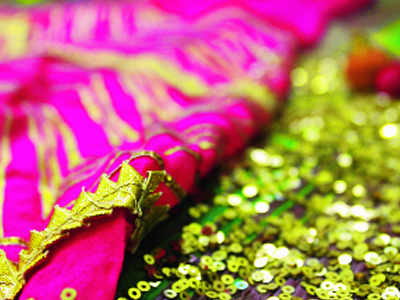Trending
This story is from July 29, 2015
The embroidery perfect for pre-wedding occasions
Gota Patti, once a fashion-essential for Mughal royalty, has re-interpreted itself as trendy wedding apparel.

Gota Patti, once a fashion-essential for Mughal royalty, has re-interpreted itself as trendy wedding apparel.
This intricate technique of embroidery that uses cotton and metal, used to be crafted out of gold and copper fibres, but is now made from synthetic fibres. Bhavna Bhatia, a designer, says that we can find the best gota kinari (or gota borders) in Jaipur, Udaipur, Ajmer or Bikaner.No surprise, as Rajasthan is where this art hails from. Even today, it complements wedding functions such as mehndi, or sangeet. However, these days, gota is frequently relegated to the edges of saris and lehengas (full skirts). It is also more popularly used with bright greens and yellows, reds and pinks.
Done by hand, gotta work often looks heavy and rich, but is extremely light to wear. I try to reinterpret it in smaller, lighter patterns.
Udaipur, Kota, Bikaner, Ajmer and of course the pink city of Jaipur still house some of the best gota craftsmen.
Also known as lappe ka kaam, gota kinari (work) is most commonly used on the edges of the garment, especially lehngas, ghagras and dupattas.
Gota patti is often employed on fabrics such as bandhini, silk, chiffon and georgette.
Gota kinari is very appropriate for mehndi/ sangeet and haldi ceremonies — it complements the colourful, playfullness of the occasion.
This style of embroidery is timeless and classic. It only gets richer in time, and there’s simply no fashion era/trend that it can be constrained to.
Gota is a yarn made of cotton in warp and metal in weft. During earlier times real gold was used. However, today it has been replaced by synthetic fibres.
The royals paired gota with bright hues — radiant reds and pinks, yellows and greens.
Now, the new style of synthetic fibre that is used to make gota is more durable. It comes in different widths for different borders and edges.
Earlier, gotta was mostly employed in floral patterns, paisley motifs, and animal prints.
It can also be used in different ways — by twisting the gota ribbons with the help of machine embroidery. Accessorising it with zari and threadwork also works well.
This intricate technique of embroidery that uses cotton and metal, used to be crafted out of gold and copper fibres, but is now made from synthetic fibres. Bhavna Bhatia, a designer, says that we can find the best gota kinari (or gota borders) in Jaipur, Udaipur, Ajmer or Bikaner.No surprise, as Rajasthan is where this art hails from. Even today, it complements wedding functions such as mehndi, or sangeet. However, these days, gota is frequently relegated to the edges of saris and lehengas (full skirts). It is also more popularly used with bright greens and yellows, reds and pinks.
Done by hand, gotta work often looks heavy and rich, but is extremely light to wear. I try to reinterpret it in smaller, lighter patterns.
Udaipur, Kota, Bikaner, Ajmer and of course the pink city of Jaipur still house some of the best gota craftsmen.
Gota patti originated in Rajasthan, during the Mughal era. It was a popular form of embroidery on ensembles worn by royalty.
Also known as lappe ka kaam, gota kinari (work) is most commonly used on the edges of the garment, especially lehngas, ghagras and dupattas.
Gota patti is often employed on fabrics such as bandhini, silk, chiffon and georgette.
Gota kinari is very appropriate for mehndi/ sangeet and haldi ceremonies — it complements the colourful, playfullness of the occasion.
This style of embroidery is timeless and classic. It only gets richer in time, and there’s simply no fashion era/trend that it can be constrained to.
Gota is a yarn made of cotton in warp and metal in weft. During earlier times real gold was used. However, today it has been replaced by synthetic fibres.
The royals paired gota with bright hues — radiant reds and pinks, yellows and greens.
Now, the new style of synthetic fibre that is used to make gota is more durable. It comes in different widths for different borders and edges.
Earlier, gotta was mostly employed in floral patterns, paisley motifs, and animal prints.
It can also be used in different ways — by twisting the gota ribbons with the help of machine embroidery. Accessorising it with zari and threadwork also works well.
End of Article
FOLLOW US ON SOCIAL MEDIA









